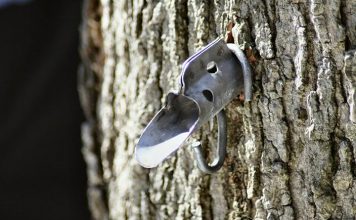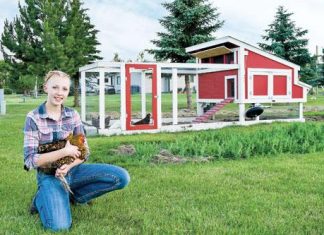 |
|
| Issue #94 • July/August, 2005 |
Self-reliance is a mindset. If you have it, you are on your way to independence. If you don’t, it would be in your best interest to develop it. It requires a conscious effort of replacing an “I need help” attitude to an “I can do it myself” attitude.
I was lucky; I acquired it at an early age by default. I grew up in a large family with no money for anything but the barest necessities. If we wanted something extra, we had to work at an outside job to get it. We didn’t resent that reality; it was a given. There was no sense of “entitlement” in our family. We were raised with the philosophy that nobody owed us anything.
An example of the self-reliant mindset already in place at 5 years old is illustrated by my first day of school. I got on the bus with my brothers and sisters and felt happy and proud that I was all grown up and on my way to schooluntil my older sister left me off at my classroom and disappeared. I loved the learning part that day, but it was over-shadowed by being worried sick about how I was going to find my way home (5 miles away). It never occurred to me that I could actually ask for help to find the right bus at the end of the day. I truly believed it was solely up to me to figure it out, and if I didn’t, I would be spending the night in the dark parking lot.
The sense of abandonment I felt was seared into my brain and probably contributed to the life-long desire for security I still have. But strangely enough, I handled my problem that day by exhausting all options possible before crying for help. I did manage to get on the right bus and I remembered feeling really good about finding it “all by myself!”
Therein lies the silver-lining of self-reliance. When you achieve even a modicum of it, you feel really good about yourself.
There are degrees of self-reliance, and even a little bit is better than none, but let’s assume your goal is “extreme self-reliance”, like mine was: Move to a small town, buy 5-10 acres in the country, build a house, have your own water supply and septic system, and possibly be off the grid for your electricity. Have a few chickens, assorted dogs and cats, and a nice garden. Work at a job you like (ideal) or one you don’t like (survival), and simplify your life to the point that you can spend every extra cent for developing your property.
I still drive an old truck, buy my clothes at Goodwill, eat plain healthful food, and don’t give a hoot about what anybody thinks. That’s another mindset to achievefreedom from the shackles of convention. When you become a landowner and you start actually achieving your goals in tiny steps, and you can visualize the end result, all of a sudden it really doesn’t matter if your hair is messed up and you have dried caulk under your fingernails. You’ll be on a roll. You’ll have more important things on your mind, like survival.
Obviously there are some personal requirements for becoming self-reliant: You have to want it badly, and you’ll have to be in pretty good shape. You’ll end up in excellent shape, but you should be fairly healthy to begin with. It helps to dream big and visualize what you want because that’s what keeps you going, but focusing your energy on the task at hand is what makes it happen. Have a plan and a list of priorities and start transforming wishful thinking into labor.

You are smarter and more capable than you think. You can’t learn if you don’t try. If a task looks daunting, get started anyway. Take it one tiny step at a time. Dream big but take baby steps. Write down a plan. List your priorities. Number them. Start in. You want to design your own house? Go downtown and buy graph paper and a ruler. Go to the library or magazine rack and look at house plans. Ideas will snowball. The mind does funny things when you give it a problem. It keeps on working overtime. In fact, you can’t shut it off. It’s important to get started with something tangible. Make a model. You’ll see there’s no big mystery to putting a house together. The sum total always looks bigger than the parts…but a house is just one board put up at a time. My house was one log at a time.
To achieve self-sufficiency, you have to delay gratification. The only instant satisfaction you’re likely to get for a while will come in tiny increments like hammering a nail in straight and cutting right on the line with the saw.
Each little job is an end in itself, but a stepping stone to the next level. You’ll be living in the moment, but working like hell for the future. Some of those moments won’t be happy, but they’ll always be meaningful. Real happiness is found in the everyday struggles and the little peak experiences you can glean out of them. Hsun-Tzu said: “If there is no dull and determined effort, there will be no brilliant achievement.” I don’t know who in the heck Hsun-Tzu was or even how to pronounce his name, but he was a wise man. Progress happens in tiny increments. And when you are the one doing the work, each little accomplishment is a big deal.
Sometimes you have to do what doesn’t come naturally.
People who read my articles and see the house I built call me a “Gutsy Lady.” That couldn’t be further from the truth. I’m actually quite wimpy and hesitant to try new things, but if I want something passionately enough, my drive over-rides my fear. Years ago I raced motorcycles because we had a motorcycle shop and my husband wanted me and the kids involved. I am not by nature an aggressive competitive female and I was terrified at first, but so motivated to please my husband that I donned my leathers and “skidshoe” every weekend and actually got good enough to win some flat-track races, even against men. I’m telling you this story just in case you are a woman who can’t even imagine doing something like that. I couldn’t either, until I tried.
I had been raised with traditional 1950’s values where the woman is the caregiver….she makes dinner, makes the kids, and makes her husband happy. That’s all fine if you aren’t sacrificing your very soul to do it. My marriage turned out to be so one-sided that I eventually had to get out.
If I could break free to develop my potential and become self-reliant, anybody can. At 30 I was a divorced woman with two kids to support on waitress earnings and no child support. And I was a “girlie-girl” and a “fraidy cat” to boot. But there was one thing I was never afraid of work, hard tortuous work! I believed fervently that I could create what I wanted by myself, within realistic financial and physical capabilities, and I didn’t care how long it took. I didn’t get started until I was 38, and now, 24 years later, I’m still working at it.
No one is confident about everything, certainly not me. I learned by mistakes and failures (Darn! I cut that board ½” too short!). I had YEARS of “oops” and “darns!” I learned that if you can accept your mistakes, it will free you up to take more risks. Trying until you get it right is how most people learn things. Perfectionism = procrastination and paralysis. You have to cut yourself some slack (just don’t cut yourself!) A job done reasonably well is good enough!
Every time you are confronted with a new task that requires learning a new skill, hit the books! That’s how I learned everything I know, by reading and practicing.
Even if you have money, do it yourself. The actor, Harrison Ford, repairs his own fences and makes furniture in his shop. There’s a reason for this. It’s profoundly satisfying. There is no shortcut to get that feeling, and no substitute for it.
If you do have plenty of money, and can hire everything done, and buy all the goods and supplies needed to survive in your home and possibly your custom-made bomb shelter, remember this old saying: “The real measure of a person’s character isn’t how well he or she does in bad times, but how well he or she keeps striving in good times.”
If you are lucky enough to have a wonderful mate, you can still become incredibly self-reliant if you make a conscious effort to do so. To this day I tend to let a man take over if there’s one around. It’s biology and conditioning. It’s also nice to have “man-power.” Men are a lot stronger. But if you find yourself single and alone you can manage anyway.
My niece is a single mom who sent me an email recently telling how she moved a washer and dryer up some steps and into her house all by herself. She said: “When you don’t have might, you tend to use your wits!” She proved there is more than one way to solve a problem.
Self-reliance is learned. It’s a process of acquiring the knowledge and skills necessary to enable you to take calculated risks and achieve your goals even if you don’t have a partner. When you have tools and know how to use them, everything seems possible! And, you know what? It IS!
Learn more about Dorothy and/or contact her at her website www.dorothyainsworth.com














There have been many jobs I was afraid to do an will probably be many more. I know I will learn to do them anyway. Upon reflection, I am amazed at some of the accomplishments in my life. There are very few things a woman cannot do if when has the education and tools. Many materials come with instructions. Take time to read and follow them. There are online videos. Develop an ongoing relationship with a store where you buy stuff or find a mentor who can advise you on new projects. Be willing to proceed slowly and methodically when doing something for the first time. Extreme cleanliness influences the outcome of many projects. Often, just being conscientious and following directions makes all the difference. If you fail, consider it an education (hopefully cheap). Learn from it. Know when to hire someone, rent or buy equipment or ask for help. There are some things you cannot do by yourself and should not do alone for safety reasons.
Make sure everyone knows where a copy of clear readable directions to your property from town and first aid supplies are stored–maybe in a work vehicle. Your house number should be posted at the road and highly visible to emergency vehicles–maybe with a distinguishing landmark. We include a military-style tourniquet that can be applied with one hand in 15 seconds, etc. in a first-aid kit. Not just band-aids. Any special medications such as bee-sting for those who might be allergic. Much will depend on the kind of work you do. You may also want a fire extinguisher. Get first-aid training. Even if you never use a cell phone, if you can get reception, it may be a valuable piece of safety equipment to carry in case of ever needing to call an ambulance.
Generally, the more encumbered you are by heavy safety gear you must carry, the less safe you are because you cannot move fast or efficiently if safety requires moving away from danger. Good boots, protective clothing, safety vests, eye protection and hard hats may be advisable as protection.
Wonderful post however I was wondering if you could write a litte more on this topic?
I’d be very grateful if you could elaborate a little bit further.
Many thanks!